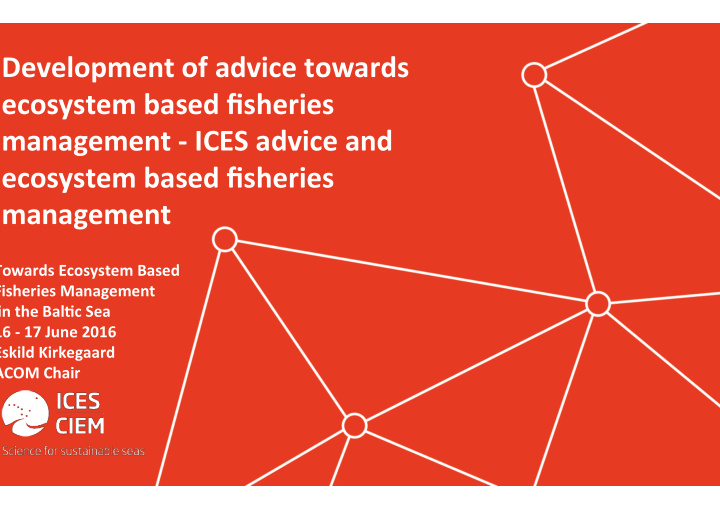



Development of advice towards ecosystem based fisheries management - ICES advice and ecosystem based fisheries management Towards Ecosystem Based Fisheries Management in the Bal7c Sea 16 - 17 June 2016 Eskild Kirkegaard ACOM Chair
Common Fisheries Policy - Objec7ves The CFP shall ensure that fishing and aquaculture ac5vi5es are environmentally • sustainable in the long-term and are managed in a way that is consistent with the objec5ves of achieving economic, social and employment benefits, and of contribu5ng to the availability of food supplies. The CFP shall apply the precau5onary approach to fisheries management, and shall • aim to ensure that exploita5on of living marine biological resources restores and maintains popula5ons of harvested species above levels which can produce the maximum sustainable yield. The CFP shall implement the ecosystem-based approach to fisheries management so • as to ensure that nega5ve impacts of fishing ac5vi5es on the marine ecosystem are minimised, and shall endeavor to ensure that aquaculture and fisheries ac5vi5es avoid the degrada5on of the marine environment. What is ecosystem based fisheries management?
Common Fisheries Policy - Objec7ves environmentally sustainable, • economic, social and employment benefits , • precau7onary approach, • maximum sustainable yield, • ecosystem-based approach to fisheries management. • What is ecosystem based fisheries management?
Ecosystem-based approach to fisheries management – defini7on in the CFP Means an integrated approach to managing fisheries within ecologically meaningful boundaries which seeks to manage the use of natural resources, taking account of fishing and other human ac5vi5es, while preserving both the biological wealth and the biological processes necessary to safeguard the composi5on, structure and func5oning of the habitats of the ecosystem affected, by taking into account the knowledge and uncertain5es regarding bio5c, abio5c and human components of ecosystems. What is ecosystem based fisheries management?
Na5onal Marine Fisheries Service Na5onal Oceanic and Atmospheric Administra5on (NOAA) NOAA Fisheries defines EBFM as a systema(c approach to fisheries management in a geographically specified area that contributes to the resilience and sustainability of the ecosystem; recognizes the physical, biological, economic, and social interac(ons among the affected fishery-related components of the ecosystem, including humans; and seeks to op(mize benefits among a diverse set of societal goals. What is ecosystem based fisheries management?
Ecosystem Based Management Balancing human ac5vi5es & environmental stewardship in a mul5ple use context What is ecosystem based fisheries management?
Trade-offs between fisheries, commercial species, and other ecosystem components (e.g., other species, habitats, and humans) and processes that affect, or are affected by, fisheries. Ecosystem Health and Sustainability Volume 2, Issue 4, 26 APR 2016 DOI: 10.1002/ehs2.1213 h]p://onlinelibrary.wiley.com/doi/10.1002/ehs2.1213/full#ehs212 fig-0001 What is ecosystem based fisheries management?
EBFM – ICES Advice ICES Advice deliverables
o Stock advice – fishing opportuni7es, how much can you take out of the stock next year, CFP objec7ve. o Fisheries overviews – how, whom, where and when, mixed fisheries and ecosystem impacts. o Ecosystem overviews – human ac7vi7es, pressures and state ICES Advice deliverables
8.3.10 Herring ( Clupea harengus ) in Subdivision 30 (Bothnian Sea) ICES stock advice ICES advises that when the MSY approach is applied, catches in 2016 should be no more than 96 613 tonnes. Stock development over time Stock advice – The spawning-stock biomass (SSB) increased until the beginning of the 1990s; then the stock decreased, but showed increase from the end of the 1990s and has been above MSY B trigger since 1986. Fishing mortality has been below F from the very beginning of the time-series, and just above since 2012. Recruitment is variable and increasing over tim fishing opportuni7es How many tonnes can you take out of the stock next year? Present stock status and dynamics: Figure 8.3.10.1 Herring in Subdivision 30. Summary of stock assessment (weights in thousand tonnes). Recruitment and SSB in 20 are predicted. Recruitment, F, and SSB have confidence intervals (95%) in the plot. Growth, maturity Stock and exploitation status Ø Stock recruitment Table 8.3.10.1 Herring in Subdivision 30. State of the stock and fishery, relative to reference points. Ø Fishing pressure Stock size Preda5on mortality 2012 2013 2014 2013 2014 2015 Ø MSY Maximum F MSY Above Above trigge Sustainable Yield B trigger Above pote Precautionary F pa , Undefined B pa , B lim candidate approach F lim reference p Management Plan F MGT - - - Not applicable SSB MGT - - - Not applica ICES Advice on fishing opportuni5es
Reference points are based on single stock considera5ons and does not include species interac5on ICES Advice deliverables
Bal7c mul7species interac7ons Fishery catch catch Cod eastern Baltic Sprat Baltic predation predation less/more recruits more/less recruits predation predation predation food competition Dorscheier higher / lower oxygen content and salinity higher / lower winter temperatures predation Herring central Baltic post-1990ies pre-1990ies Pseudocalanus acuspes Acartia spp. Path 1 Path 2 more & stronger inflow, less terrestrial runoff, weak inflows, Path 1 Path 2 surface more saline, more terrestrial runoff, Hydrography deep water more oxygen more nutrients mainly inflow event freq. Climate positive NE-Atlantic Oscillation Index, change of high and low pressure areas
Mul7species modelling Trade-offs and priori5es WKMULTBAL 2012
Fmsy ranges - Sprat MSY MSY F upper MSY B trigger Stock F MSY F lower with AR (thousand t) Sprat 0.19 0.26 0.27 570
Fisheries overviews How, whom, where and when, mixed fisheries and ecosystem impacts. MSFD descriptors Total fishing effort (hours) Q1–Q4 2013. Mobile bo]om contac5ng gears, midwater trawls, and longlines. Fisheries overviews
Ecosystem overviews
Ecosystem based approach – ICES advice Trade-offs/priori(es between fisheries, commercial species, and other ecosystem components (e.g., other species, habitats, and humans) and processes that affect, or are affected by, fisheries. Economic and social interac(ons ICES advice
TAC and quotas Technical measures including closed areas/seasons Fisheries management
Thank you
Recommend
More recommend